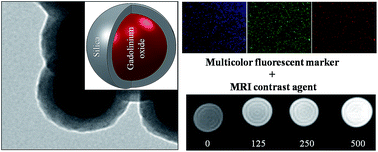Multicolor nanoprobes based on silica-coated gadolinium oxide nanoparticles with highly reduced toxicity†
Abstract
In recent years, multimodal contrast agents have attracted considerable attention in biomedical imaging. This paper reports the development of a multimodal nanoprobe based on silica-coated gadolinium oxide nanoparticles (NPs) for T1-enhanced magnetic resonance (MR) and multicolor optical imaging. MR relaxivity measurements showed that these core–shell NPs could generate strong positive contrast enhancement in T1-weighted MR imaging (MRI). Owing to the nominally co-doped Eu3+ and Tb3+ ions in the Gd2O3 host, the synthesized nanoprobes could simultaneously emit blue, green and red fluorescence signals. Furthermore, the cytotoxicity results showed that a thin silica coating on the surface of gadolinium oxide NPs could increase the biocompatibility of the fabricated nanoprobes considerably. The excellent multicolor fluorescence and MRI functionalities of these nanoprobes could have potential biomedical applications.



 Please wait while we load your content...
Please wait while we load your content...